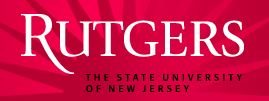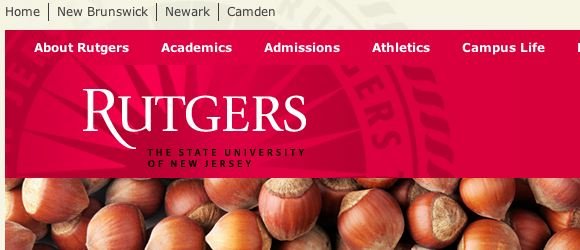Lessons from the Amanda Serpico Plagiarism Case
 Local media in New Jersey is talking about the case of Amanda Serpico, a former Rutgers student who was accused of plagiarism in her “Argumentation” course at the college.
Local media in New Jersey is talking about the case of Amanda Serpico, a former Rutgers student who was accused of plagiarism in her “Argumentation” course at the college.
As part of the class, she wrote an opinion paper arguing on the politics of gay marriage. While everything seemed well after turning in the assignment, two days before Christmas (after the course had ended and she was on break), the instructor of the course emailed her and informed her that plagiarism had been detected in her work.
Serpico fought back, claiming that the software used for the detection, Turnitin, is flawed and appealed every step in the disciplinary process. However, she eventually lost and received an “F” for the course on her transcript. Further, though she was allowed to graduate, according to Serpico, that “F” may have resulted in her being denied admission to graduate school at the University of South Carolina, her first choice, and the University of Texas at Austin, her second.
Serpico is now suing Rutgers to have the grade changed though it is unclear if that is even capable of having an effect. In the meantime, she was accepted at Florida State University and is studying there.
The case, to put it modestly, is a mess for both sides. Not only has Serpico’s academic career been set back, but Rutgers is now fending off questions about its plagiarism practices. The public outing of the case, which was Serpico’s decision, has put both in a negative light publicly.
But what can be learned from this? A great deal if one is willing to read between the lines of the story.
Did Serpico Plagiarize?
The big question in this matter is whether or not Serpico actually plagiarized. Unfortunately, without access to her paper and/or the Turnitin report, I can’t really make any determination. I can only take Serpico and the school at their word and that leaves a lot of room for error.
Still, there are a few interesting points in the story.
- After the initial accusation of plagiarism and Serpico’s response, the instructor admitted that much of the paper was correctly cited but said that there were three passages that were not. Though it’s unclear how long the passages are, the instructor said they, “take up so much of the total text in your paper… I am left with no other choice than to formally treat this as a case of plagiarism.”
- Serpico said that the three sources involved, were cited in the works cited section, “Even if they were not properly cited within text, they were clearly made visible on my reference page at the end of my paper,” Serpico wrote in an appeal.
- Despite a vigorous appeal, which included an 8-page response, Serpico eventually lost her case before the disciplinary board and received an “F” for the assignment.
The problem, based on this information, seems fairly clear. Since Turnitin (as well as all plagiarism checking services) can only detect verbatim copying, Serpico, most likely, used several passages verbatim and, though cited them in the works cited section of the paper, failed to cite them correctly in the text (quotes and attribution).
If that’s the case, then quite clearly this is plagiarism. When using text verbatim, especially in any large amount and in an academic environment, you’re supposed to mark it as a quote. This is designed to indicate that you did not write the words yourself and that they came straight from the credited source. This is both to indicate where the words came from and that the thoughts/phrasing are not your own, this is especially important in an argumentative paper, such as this one.
So it’s clear, if we assume the above is true, that Serpico at least technically violated the school’s plagiarism rules. The tougher question is if it was intentional or accidental. That will depend much more on the length of the passages at issue, something I can’t speak to as I don’t have the paper.
That being said, Serpico said that she is willing to “share all of the documents related to her case” and, if she does so with me, I’ll write a follow up article later this week on the topic. Unfortunately, I was unable to contact her for this story.
Other Statistics
One interesting element to this story is the statistics Rutgers provided on cheating and plagiarism at its school.
According to them, some 344 students last year were cited for cheating, 70% of which (241) were for plagiarism. From there, 92% of the students who were accused faced some level of discipline, whether it was failing the class, a 0 on the assignment or some other discipline.
Most students accepted responsibility for their actions and did not appeal the rulings.
What all of this does is paint a picture of just how unusual Serpico’s case is. Though plagiarism cases are more common than earlier, most seem to be dealing with very clear-cut cases of plagiarism where the student admits to the error, receives punishment and moves on. Rarely is there even an appeal.
However, this is exactly the scenario that students and instructors alike fear. When every student turns in a paper, they fear an incident where they feel they did nothing wrong (or maybe just made an innocent mistake) but are accused of plagiarism and suffer dire consequences.
Serpico, in short, is a poster child for what students are afraid of with tools like Turnitin being used.
That, in turn, shows what educators need to glean from this.
Quick Lessons from the Case
So what are the lessons from this case, as I see it, there are three major ones to learn:
- Turnitin is Not Magical: No plagiarism check can actually spot plagiarism, they can only detect verbatim copying. While that’s a powerful too, teachers need to use their judgment to decide if the copying is plagiarism or not. Judging from the response of the instructor in this case and how the story changed after the first week, it seems like, initially at least, the Turnitin report was handled inappropriately.
- Education vs. Discipline: Was this a case that warranted disciplinary action or would an educational approach been better? I can’t say without looking at the paper, but given that Serpico still is unclear on what she did wrong, it seems at least some educational opportunity was missed.
- Plagiarism is a Serious Allegation: Even though the punishment Serpico faced was fairly mino compared to other schools, it has still had strong consequences on her academic career, at least apparently. These allegations can’t be taken lightly and we must be careful that the crime warrants the punishment. This is especially true consider, at Rutgers, these cases will stay on the student’s record for at least 10 years, possibly permanently.
All in all, this reenforces my original statements that schools need to move away from a purely disciplinary mindset on plagiarism and start looking at it more as an educational issue.
However, as Rutgers’ statistics show, that isn’t likely to happen anytime soon.
Bottom Line
All in all, I can’t make any final determinations in this case without the paper in front of me. However, even with the limited information we have in hand, there’s a lot that this can teach us about how plagiarism can and should be handled in academic environments.
To be clear though, it seems unlikely that Serpico’s lawsuit is going to do much good. The deck is just stacked too far in the school’s favor. Even ignoring the agreements Serpico signed to go to the school, it’s unclear what law she would use to force the change. She may be able to claim libel, but she has an uphill battle there as there is at least some evidence against her.
Still, it will be an interesting case and one that schools everywhere will be watching.
Want to Reuse or Republish this Content?
If you want to feature this article in your site, classroom or elsewhere, just let us know! We usually grant permission within 24 hours.
